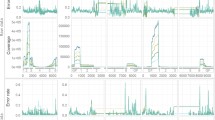Abstract
Competent laboratories monitor genetically modified organisms (GMOs) and products derived thereof in the food and feed chain in the framework of labeling and traceability legislation. In addition, screening is performed to detect the unauthorized presence of GMOs including asynchronously authorized GMOs or GMOs that are not officially registered for commercialization (unknown GMOs). Currently, unauthorized or unknown events are detected by screening blind samples for commonly used transgenic elements, such as p35S or t-nos. If (1) positive detection of such screening elements shows the presence of transgenic material and (2) all known GMOs are tested by event-specific methods but are not detected, then the presence of an unknown GMO is inferred. However, such evidence is indirect because it is based on negative observations and inconclusive because the procedure does not identify the causative event per se. In addition, detection of unknown events is hampered in products that also contain known authorized events. Here, we outline alternative approaches for analytical detection and GMO identification and develop new methods to complement the existing routine screening procedure. We developed a fluorescent anchor-polymerase chain reaction (PCR) method for the identification of the sequences flanking the p35S and t-nos screening elements. Thus, anchor-PCR fingerprinting allows the detection of unique discriminative signals per event. In addition, we established a collection of in silico calculated fingerprints of known events to support interpretation of experimentally generated anchor-PCR GM fingerprints of blind samples. Here, we first describe the molecular characterization of a novel GMO, which expresses recombinant human intrinsic factor in Arabidopsis thaliana. Next, we purposefully treated the novel GMO as a blind sample to simulate how the new methods lead to the molecular identification of a novel unknown event without prior knowledge of its transgene sequence. The results demonstrate that the new methods complement routine screening procedures by providing direct conclusive evidence and may also be useful to resolve masking of unknown events by known events.

Molecular toolbox for the identification of genetically modified organisms







Similar content being viewed by others
References
James C (2009) ISAAA brief 39
Stein AJ, Rodríguez-Cerezo E (2009) European Communities, Luxembourg, JRC Technical Report EUR 23486 EN
Stein AJ, Rodríguez-Cerezo E (2009) European Communities, Luxembourg, JRC Technical Report EUR 23810 EN
Community Reference Laboratory for GM Food and Feed (2009) . Status of dossiers. http://gmo-crl.jrc.ec.europa.eu/statusofdoss.htm. Accessed 30 Sept 2009
Dorey E (2000) Nat Biotechnol 18:1136–1137
European Commission (2005) Off J Eur Union 101:14–16
European Commission (2006) Off J Eur Union 306:17–20
European Commission (2008) Off J Eur Union 96:29–34
Vermij P (2006) Nat Biotechnol 24:1301–1302
Holst-Jensen A (2008) Nat Biotechnol 26:858–859
Ruttink T, Morisset D, Van Droogenbroeck B, Lavrac N, Van Den Eede G, Zel J, De Loose M (2009) Anal Bioanal Chem. doi:10.1007/s00216-009-3218-6
ACP Pharma (2008) http://www.orfe.pl/wyniki_wyszukiwania.php?szukaj=acp_magazyn_03_2008.pdf Accessed 30 Sept 2009
Kuribara H, Shindo Y, Matsuoka T, Takubo K, Futo S, Aoki N, Hirao T, Akiyama H, Goda Y, Toyoda M, Hino A (2002) J AOAC Int 85:1077–1189
Hernandez M, Rodriguez-Lazaro D, Ferrando A (2005) Curr Anal Chem 1:203–221
Xu J, Miao H, Wu H, Huang W, Tang R, Qiu M, Wen J, Zhu S, Li Y (2006) Biosens Bioelectron 22:71–77
Holst-Jensen A, Rønning SB, Løvseth A, Berdal KG (2003) Anal Bioanal Chem 375:985–993
Leimanis S, Hernández M, Fernández S, Boyer F, Burns M, Bruderer S, Glouden T, Harris N, Kaeppeli O, Philipp P, Pla M, Puigdomènech P, Vaitilingom M, Bertheau Y, Remacle J (2006) Plant Mol Biol 61:123–139
Prins TW, van Dijk JP, Beenen HG, Van Hoef AA, Voorhuijzen MM, Schoen CD, Aarts HJ, Kok EJ (2008) BMC Genomics 9:584
Schmidt AM, Sahota R, Pope DS, Lawrence TS, Belton MP, Rott ME (2008) J Agric Food Chem 56:6791–6800
Chaouachi M, Chupeau G, Berard A, McKhann H, Romaniuk M, Giancola S, Laval V, Bertheau Y, Brunel D (2008) J Agric Food Chem 56:11596–11606
Randhawa GJ, Chhabra R, Singh M (2009) J Agric Food Chem 57:5167–5172
Mano J, Shigemitsu N, Futo S, Akiyama H, Teshima R, Hino A, Furui S, Kitta K (2009) J Agric Food Chem 57:26–37
Elenis DS, Kalogianni DP, Glynou K, Ioannou PC, Christopoulos TK (2008) Anal Bioanal Chem 392:347–354
Hamels S, Glouden T, Gillard K, Mazzara M, Debode F, Foti N, Sneyers M, Nuez TE, Pla M, Berben G, Moens W, Bertheau Y, Audeon C, Van den Eede G, Remacle J (2009) Eur Food Res Tech 228:531–543
Miraglia M, Berdal KG, Brera C, Corbisier P, Holst-Jensen A, Kok EJ, Marvin HJ, Schimmel H, Rentsch J, van Rie JP, Zagon J (2004) Food Chem Toxicol 42:1157–1180
GMO Compass (2009) http://www.gmo-compass.org. Accessed 30 Sept 2009
Cankar K, Chauvensy-Ancel V, Fortabat MN, Gruden K, Kobilinsky A, Žel J, Bertheau Y (2008) Anal Biochem 376:189–199
Raymond P, Gendron L, Paul S, Moreau ME, Coté MJ, Laberge S (2008) In: Book of abstracts. First Global Conference on GMO Analysis, Como, Italy, 24–27 June 2008
Bhat NS, Dibley K, Xie VRD, Partis L, Raymond P, Emslie KR (2008) In: Book of abstracts. First Global Conference on GMO Analysis, Como, Italy, 24–27 June 2008
Nesvold H, Kristoffersen AB, Holst-Jensen A, Berdal KG (2005) Bioinformatics 21:1917–1926
Querci M, Foti N, Bogni A, Kluga L, Broll H, Van den Eede G (2009) Food Anal. Methods. doi:10.1007/s12161-009-9093-0
Theuns I, Windels P, De Buck S, Depicker A, Van Bockstaele E, De Loose M (2002) Euphytica 123:75–84
Windels P, De Buck S, Van Bockstaele E, De Loose M, Depicker A (2003) Plant Physiol 133:2061–2068
Alonso JM et al (2003) Science 301:653–657
Dong W, Yang L, Shen K, Kim B, Kleter GA, Marvin HJP, Guo R, Liang W, Zhang D (2008) BMC Bioinformatics 9:260
Fedosov SN, Laursen NB, Nexø E, Moestrup SK, Petersen TE, Jensen EØ, Berglund L (2003) Eur J Biochem 270:3362–3367
Hvas AM, Buhl H, Laursen NB, Hesse B, Berglund L, Nexo E (2006) Haematologica 91:805–808
GM Database (2009) Agbios. http://www.agbios.com/dbase.php. Accessed 30 Sept 2009
Debode F, Janssen E, Berben G (2007) Eur Food Res Tech 226:273–280
GMOtrack (2009) http://kt.ijs.si/software/GMOtrack/. Accessed 30 Sept 2009
Acknowledgements
T. Ruttink is supported by the Belgian Federal Public Service for Health, Food Chain Safety, and Environment (contract no. RT-06/6 GMOdetec). R. Demeyer is indebted to the Institute for Agricultural and Fisheries Research (ILVO) for a predoctoral fellowship. I. Taverniers was involved in the 6th Framework Programme Integrated Project Co-Extra, Contract No. 007158. We are thankful for the excellent technical support of Annique Staelens, Cindy Merckaert, Mieke Dhondt, and Sabine van Glabeke.
Author information
Authors and Affiliations
Corresponding author
Additional information
T. Ruttink and R. Demeyer contributed equally to this work.
Electronic supplementary material
Below is the link to the electronic supplementary material.
ESM 1
(PDF 1957 kb)
Rights and permissions
About this article
Cite this article
Ruttink, T., Demeyer, R., Van Gulck, E. et al. Molecular toolbox for the identification of unknown genetically modified organisms. Anal Bioanal Chem 396, 2073–2089 (2010). https://doi.org/10.1007/s00216-009-3287-6
Received:
Revised:
Accepted:
Published:
Issue Date:
DOI: https://doi.org/10.1007/s00216-009-3287-6




